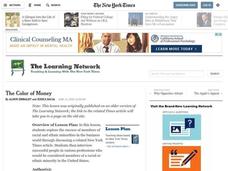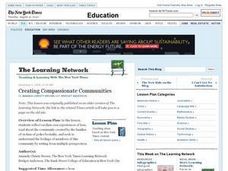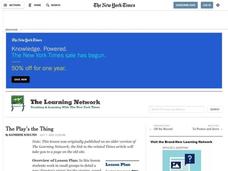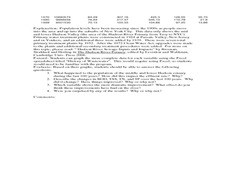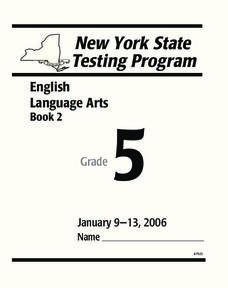Curated OER
History, Today and Every Day
Students assess, by analyzing historic New York Times front pages, how print journalism reflects the values and language of the society in which it is created.
Curated OER
Out of the Fire
Students share ideas about a lead for a breaking news story regarding the California wildfires. They brainstorm angles for a series of news items and write analysis papers that address the tone and content of a piece published in The New...
Curated OER
In My Honest Opinion
Students explore the function of letters to the editor for both a newspaper and its readers. They select a current event about which he or she feels strongly, reads a related New York Times article and responds to it in a letter to the...
Curated OER
The Color of Money
Young scholars explore the success of members of racial and ethnic minorities in the business world through discussing a related New York Times article. They interview successful people in various professions who would be considered...
Curated OER
On the Leading Edge
Pupils write an op-ed piece concerning presidential leadership. After reading an archived article from The New York Times, students compare and contrast the leadership styles of former Vice President Al Gore and President George W....
Curated OER
Discovery Channels
Young scholars read a New York Times article in order to explore issues about the celebration of Columbus Day. They, working in groups, research the legacy of exploration and colonization. They use the research to create a first person...
Curated OER
There Must Be Something in the Water
Students read a New York Times article as a class and discuss how groundwater near a nuclear test site may have been contaminated. They explore how groundwater contamination can spread through aquifers by participating in a simulation.
Curated OER
Begging for Another Chance
Learners read a New York Times article in order to explore different perspectives on homelessness. They volunteer at sites that help the homeless and share their experiences.
Curated OER
Jewish Assimiliation in Contemporary American Literature
Students read a collection of stories and watch videos to learn about the Jewish assimilation in American literature. In this American literature lesson, students watch videos about Judaism, read stories from a contemporary Jewish...
Curated OER
Draft Dilemmas
Consider the possibility of a new U.S. draft with this lesson, which encourages class debate and persuasive arguments. Middle and high schoolers discuss how such a draft might be enacted and how they would feel about it. They write...
Curated OER
Creating Compassionate Communities
Have you ever lost someone? Middle and high school learners journal about a time they experienced the loss of someone through death, divorce, moving, or another type of change. They share their responses and discuss an article relating...
Curated OER
All the World's a Stage
Is the circus a form of theater? Read "A City of Clowns? What Else Is New?" to sway your class that a circus, is indeed, a theatrical performance. Critical thinkers compare/contrast various forms of theater and identify what makes the...
Curated OER
The Play's the Thing
Students describe to a partner theater experiences they have had in their lives that were memorable, and analyze why. They study about one director's original artistic choices for staging Shakespeare by reading and discussing "Nature's a...
Curated OER
Test-Driving Computers
A new form of standardized testing? Learners evaluate arguments for and against the use of computer-based standardized tests in schools. They express their views through discussion and explore the views of others through the creation and...
Curated OER
Historical Pollution in the Hudson: Part 2
Ninth graders practice how to format and enter data into an Excel spreadsheet, make a graph, and interpret graphed data. They recognize how the pollution in the Hudson River has changed over time, and explain the consequences of these...
Curated OER
Relative Age Dating
Modeling dough and paper cutouts in science class? Learn about how relative age dating concepts, like the Law of Superposition and cross-cutting relationships, can be used to describe the formation of sedimentary layers.
Curated OER
MLA Citation practice
Do your writers have a hard time properly citing their sources in MLA style? Use this SMART board activity to practice these skills in a fun, interactive way. After debating a topic in class (the lesson uses "random drug testing in...
Curated OER
Nov. 17, 1973 | Nixon Declares 'I Am Not a Crook'
Connect events of the past to events of today. Budding historians read an eight paragraph passage describing the Watergate scandal. They then connect the Nixon scandal to sex scandals of recent times. There are six critical thinking...
Curated OER
Informative Speech Assignment
Allow your pupils to take on the role of the instructor with an informative speech that covers a new topic related to your unit of study or new information on a subject your class has already studied. Pupils fill out the provided outline...
The New York Times
The One-Question Interview
Generate interest in current events, the theme of a new unit, or a research project. Individuals select a question from the list generated by the class, conduct one-on-one interviews, analyze the responses, draw conclusions based on...
Curated OER
I Am Seventeen Going On ?
Students explore the differences between going through adolescence in New York City in 1980 and today by reading and discussing the article, "When He Was Seventeen." They write a script for a podcast about the teen/parent relationship...
Curated OER
What's the Hold-Up?
Young scholars explore the current plan by New York City Mayor Michael Bloomberg to retain underperforming third graders in public schools. They research and debate social promotion versus retention.
Curated OER
New York City: Passionate About Shakespeare
Students read passages from Shakespeare and have a Town Hall meeting in which they defend Shakespeare as part of American culture.
Curated OER
New York State Testing English Language Arts
In this language arts exam, 5th graders complete a comprehensive packet of questions. Students respond to 27 short answer, multiple choice, and reading comprehension questions specific to grade five.



